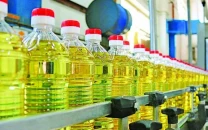Power production surges 48% in April, but load-shedding persists
Country produces highest volume of electricity with help of RLNG

PHOTO: EXPRESS
However, load-shedding still continues to haunt consumers and disrupts life and business across the country, but with less severity.
Gas-based power production surges to over 40% of energy mix
Pakistan’s power generation shot up 48% to over 10,135.08 gigawatt-hour (GWh) in April 2018 following the start of new gas-fired, coal-fired and nuclear power plants in the recent past, according to data released by the power-sector regulator.
Power production had been recorded at 6,870.24 GWh in April last year. The addition of fresh electricity to the system has helped reduce load-shedding across industrial, commercial and residential areas.
Lobbies at work to turn energy mix in their favour
According to details, Pakistan produced the highest volume of electricity with the help of re-gasified liquefied natural gas (RLNG)-based projects that generated 2,699.08 GWh or around 27% of total production in April 2018. This addition to the overall energy mix came mainly on the back of first three RLNG power plants in Punjab that came on line with a cumulative installed capacity of over 3,600 megawatts.
To perform better: K-Electric’s power generation function could be separated
Electricity generation fuelled by domestically produced natural gas rose to 1,646.04 GWh in April 2018, which constituted 16.24% of the energy mix, said the National Electric Power Regulatory Authority (Nepra).
Combined power production with the help of domestic and imported gas (RLNG) stood at around 43% (4,345.12 GWh) in the energy mix in April 2018. This demonstrated a sharp increase from around 22% (1,506.90 GWh) in April last year.
Power production by coal-fired projects rose to 1,401.61 GWh or around 14% in April 2018 compared to a meagre 15.71 GWh or 0.23% in the energy mix in April 2017. The surge in production from the dirty fuel became possible after two coal-fired power projects of installed capacity of over 2,600 megawatts came on stream - one in Punjab and one in Sindh.
Nuclear power production swelled to 835.95 GWh (8.25% of the energy mix) in April 2018 from 361.78 GWh (0.50%) in April last year, which came after the start of new projects in Sindh.
Wind power production increased to 206.67 GWh (2.04%) compared to 18.64 GWh (0.27%) in April 2017. Production from this clean source rose after the launch of several 50MW power projects in Jhimpir, Sindh.
On the flip side, electricity generation with the help of oil-based projects fell to sharply lower levels as per the government’s policy. It wants to lessen reliance on the most expensive fuels - furnace oil and diesel.
In winter last year, the government had stopped the production of around 4,000MW per hour from oil-based projects, but in summer this year it returned to the expensive fuel to meet the growing demand.
Production from furnace oil dropped to 1,550.54 GWh (15.30%) in April 2018 from 2,817.61 GWh (41.01%) in April last year.
Unfortunately, hydroelectric power generation dipped to 1,527.84 GWh (15.07%) in April 2018 from 1,903.05 GWh (27.70%) in the corresponding month of last year. The drop in the cheapest and environment-friendly source of electricity may be attributed to water mismanagement.
Published in The Express Tribune, May 22nd, 2018.
Like Business on Facebook, follow @TribuneBiz on Twitter to stay informed and join in the conversation.



















COMMENTS
Comments are moderated and generally will be posted if they are on-topic and not abusive.
For more information, please see our Comments FAQ